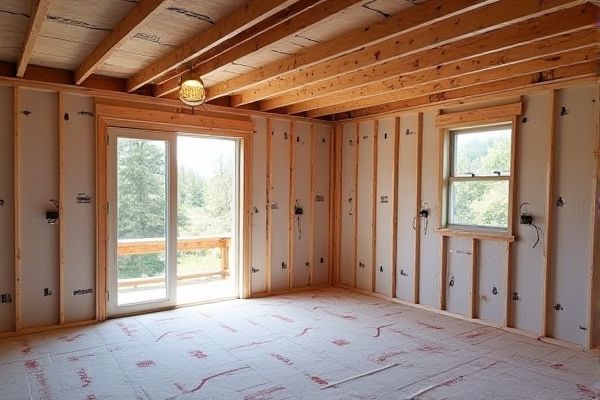
Insulation reduces heat transfer to keep your space warm or cool, while a vapor barrier prevents moisture from penetrating walls, protecting structural integrity and indoor air quality. Discover more about how to optimize your home's efficiency and comfort by reading the full article.
Table of Comparison
| Aspect | Insulation | Vapor Barrier |
|---|---|---|
| Primary Function | Reduce heat transfer, maintain temperature | Prevent moisture penetration and condensation |
| Material Examples | Fiberglass, foam board, mineral wool | Plastic sheets, foil-faced paper, polyethylene |
| Location Used | Walls, attics, floors, roofs | Installed on warm side of insulation, inside walls or ceilings |
| Effect on Energy Efficiency | High - reduces heating & cooling costs | Supports insulation by preventing moisture damage |
| Moisture Control | Minimal direct effect | Crucial for controlling vapor diffusion |
| Installation Focus | Thermal performance | Moisture barrier, air tightness |
| Lifespan | 20-50 years depending on type | Varies; can degrade if punctured or installed improperly |
Introduction to Insulation and Vapor Barriers
Insulation reduces heat transfer by trapping air within materials such as fiberglass, foam, or cellulose, improving energy efficiency and comfort. Vapor barriers control moisture movement by preventing water vapor from penetrating walls, floors, and ceilings, protecting structures from mold and decay. Effective building envelopes combine proper insulation with vapor barriers to optimize thermal performance and indoor air quality.
Definitions: What Is Insulation?
Insulation refers to materials designed to reduce heat transfer between the inside and outside of buildings, enhancing energy efficiency and comfort. Common types include fiberglass, foam board, and spray foam, each with specific thermal resistance (R-value) properties. Insulation minimizes heat loss in winter and heat gain in summer, playing a critical role in maintaining indoor temperature stability.
Understanding Vapor Barriers
Vapor barriers are materials designed to prevent moisture from penetrating walls, ceilings, and floors, reducing the risk of mold growth and structural damage. Unlike insulation, which slows heat transfer, vapor barriers specifically control the movement of water vapor to maintain a dry indoor environment. Proper installation of vapor barriers in conjunction with insulation enhances energy efficiency and prolongs building durability.
Key Differences Between Insulation and Vapor Barriers
Insulation primarily reduces heat transfer to maintain comfortable indoor temperatures and improve energy efficiency, while vapor barriers prevent moisture from penetrating walls, floors, or ceilings, protecting structural components from mold and damage. Insulation materials typically include fiberglass, foam, or cellulose, designed for thermal resistance, whereas vapor barriers are usually made from plastic sheets or foil with low permeability. Understanding the key differences helps you select the right product to optimize both energy savings and moisture control in your building.
How Insulation Works in Buildings
Insulation in buildings reduces heat transfer by trapping air within materials like fiberglass, foam, or cellulose, creating a thermal resistance known as R-value. This resistance slows the flow of heat, maintaining interior temperature and enhancing energy efficiency. Vapor barriers complement insulation by preventing moisture infiltration, which can degrade insulating materials and reduce their effectiveness.
The Role of Vapor Barriers in Moisture Control
Vapor barriers play a crucial role in moisture control by preventing water vapor from passing through walls, ceilings, and floors, thus protecting building materials from mold, mildew, and structural damage. Unlike insulation, which primarily reduces heat transfer, vapor barriers specifically address moisture migration to maintain a dry, healthy indoor environment. Ensuring your vapor barrier is properly installed can significantly enhance the durability and energy efficiency of your home.
When to Use Insulation vs Vapor Barriers
Insulation is essential for regulating indoor temperature by reducing heat transfer and maintaining energy efficiency, typically used in walls, attics, and floors. Vapor barriers are installed to prevent moisture infiltration and condensation within wall assemblies, commonly applied on the warm side of insulation in cold climates. Use insulation to control thermal performance, while vapor barriers should be used strategically to manage moisture and prevent mold or structural damage.
Installation Best Practices
Install insulation and vapor barriers with careful attention to moisture control to prevent mold growth and structural damage. Use vapor barriers on the warm side of insulation in cold climates and ensure seams are tightly sealed to maintain effectiveness. Proper installation includes avoiding compression of insulation, maintaining continuous coverage, and verifying vapor barrier integrity with overlapping seams and appropriate fasteners.
Common Myths About Insulation and Vapor Barriers
Many homeowners mistakenly believe that vapor barriers alone prevent all moisture problems, but insulation quality and proper installation are equally crucial for effective moisture control. Insulation reduces heat transfer and condensation risk, while vapor barriers specifically limit moisture diffusion within walls, requiring correct placement based on climate zones. Understanding the distinct roles and limitations of insulation versus vapor barriers helps safeguard your home against mold, structural damage, and energy inefficiency.
Choosing the Right Solution for Your Project
Selecting the appropriate insulation or vapor barrier depends on factors such as climate, building materials, and moisture control needs. Insulation enhances energy efficiency by reducing heat transfer, while vapor barriers prevent moisture infiltration that can damage structural components. Evaluating your project's specific environmental conditions will ensure you choose the optimal combination to protect your building and maximize comfort.
 homyna.com
homyna.com